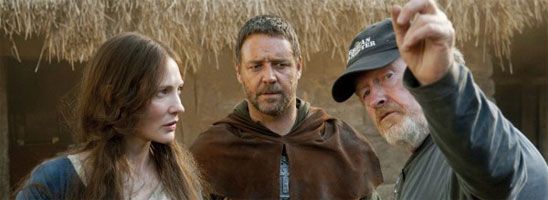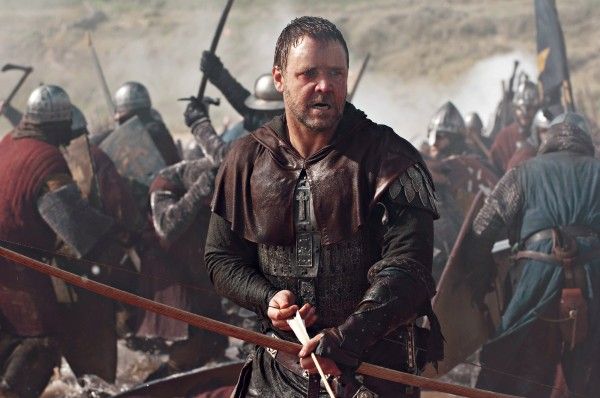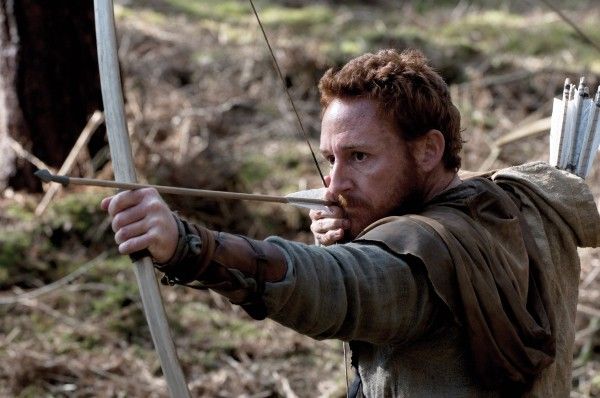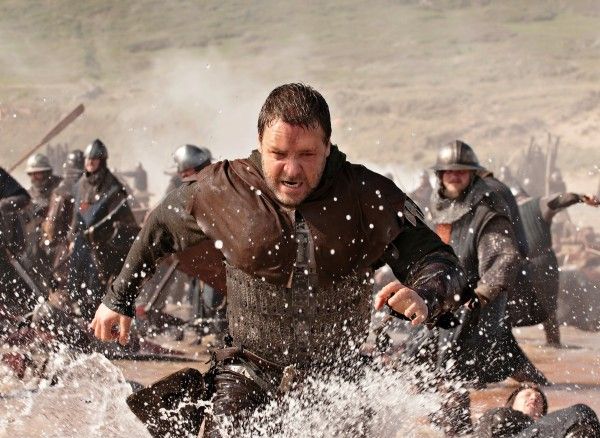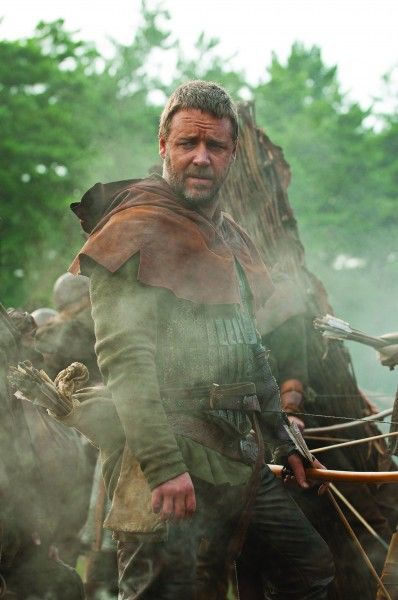With Robin Hood getting released today on DVD and Blu-ray, I was granted an audience with the man behind the arrows Steve Ralphs (Head Archer), and the man behind the weaponry Simon Atherton (Armourer), at none other than the Tower of London. Not only was the setting a significant link to the theme of the film, we were treated to a ‘Robin Hood style’ archery lesson with Steve, and a sneaky peak at the weapons and costumes used.
Two really passionate and interesting guys later I’ve been left with insight into the behind-the-scenes tips and tricks that ensure Robin Hood felt as real as possible. Interested? Hit the jump for more:
I’m not going to focus on Robin Hood, you guys can make up your minds about this representation of a British legend. What I am going to say is as an English film enthusiast, I’ve seen my fair share of Robin Hood films. Burnt into my mind are the crotch-defining tights donned by Kevin Costner in ‘Robin Hood: Prince of Thieves’, as well as the voluptuous long flowing curls paraded by Errol Flynn in ‘The Adventures of Robin Hood’. For this reason I’m sure you can understand where my enjoyment of the new ‘gritty’ Robin Hood style, and why I was delighted to find out that Russell Crowe was keeping his hair maintained and his legs lycra-free.
Steve Ralphs is known to the film and television world as ‘the bow and arrow man’, a well known authority on toxophily (posh word for an archer) for over 30 years. He’s worked on blockbusters such as Braveheart, Troy, the and The Mummy, coaching the likes of Russell Crowe, Cate Blanchett, Gerard Butler and Dame Judi Dench. Just one archery lesson with Steve Ralphs soon established that he lived and breathed archery, could kill me in seconds, and after challenging him to a competition; was a much better archer than me.
Then Simon Atherton stepped in to show us the weaponry used in the film, doubling my awareness of the ease of my demise, not only quickly now, but with an interesting array of weapons! Not surprisingly Simon has been a film armourer for most of his life, working on weapons of all descriptions, from crossbows to pulse rifles, and from blowpipes to bazookas. He has supplied period weaponry in many major releases such as Braveheart, Gladiator and Kingdom of Heaven.
Sat down with the pair my worries instantly evaporated as their passion for archery and weaponry took over conversation, both of them really fascinating people to talk to.
Interview with Simon Atherton:
Q: So how did it all start for you?
I kind of started off as a gunsmith with 5 years of training, down in Cornwall. I never dreamt of ending up in film, but someone told me of a company in London that do firearms and weapons for the film industry. Next thing I know I got the job, I stayed with that company for the next 5 years, and my first film was Indiana Jones and the Raiders of the Lost Arc, doing all the weapons for that. My first medieval film was Braveheart and I built on my reputation from that. I would never get a phone call for one sword, one rubber dagger, only for 3000 weapons, so once you get a reputation like that it goes through from producer to producer.
Q: So you’re in charge of all the weaponry on set, are they real weapons? I see extras carrying huge shields; they must surely be really heavy?
If you make a real shield, the extra will dump it, no-ones trying to kill him for real so he doesn’t think he needs to carry it around, so I’ll find a bush on set where everyone’s dumped their shields! Early on you make a decision to make things that are ‘people friendly’, for example shields constructed from cardboard, which is great because they’re light. The shield we used for Robin Hood was more of a ‘3rd generation shield’; we learnt from working on Kingdom of Heaven that coating them in glue stopped them from expanding in the rain, for example, which helped the shield evolve. This worked really well until half way through the filming with the end battle sequence, which was originally meant to be shot in the centre of London. Someone called a meeting and announced they’d changed the plan to a beach battle, with people wading through the sea and fighting, so I’m thinking beach...water...oh not water, so I turn to Janty Yates; the costume designer, to see the blood drain from her face. We ran about waterproofing everything as best we could.
Q: How about the swords?
In each film we try to find a new product to work with. Health and safety is a big issue in the film industry so they’ll encourage rubber swords, which would wobble uncontrollably. So what we did was, after learning about bamboo swords working on a Jackie Chan film, made bamboo broad swords. The stunt men loved them, the weight is in the handle, so you can run in at full speed, all the fight sequences you see are using bamboo swords.
Q: Surely close ups of weapons would reveal the bamboo sword?
For every sword you make you have to make a steel sword with all the decoration, a fighting sword, a bamboo copy and another lightweight copy. So each actor will have around five swords, all the same. To keep cost down we make the swords on a special machine, so all the blades are interchangeable, which is something I think my company specialises in.
Q: What’s the most expensive type of equipment you make?
There are two types; firstly arrows, a lot of work goes into them, then the belt. When I’m on a horse my legs are wide apart, I don’t want a sword sticking into my side, so we designed an adjustable belt. This way you can lower the sword so that it doesn’t stick in the side, then when you dismount you can raise it to stop it dragging on the ground.
Interview with Steve Ralphs:
Q: You boast a range of historically accurate different shooting styles, how do they differ? For example how does shooting an arrow in Gladiator differ to Robin Hood?
The difference is the Romans didn’t actually like archery. They had the formations of the centurians, called the quincunx, 5 people a swords distance apart. The archers were called auxillery, as they conquered countries they took the archers in. They used a horn and sinew bow because from that part of the world it’s very dry, so no wood. So you make a bow on a small wooden core, on the outside you lay sinew, from the achilleys tendon or the backstrap of an animal dried out, and on the inside of the bow you put horn from an animal, so in effect what you’re making is ancient fibreglass. Those bows can be made much shorter, which means when the string is drawn back it’s at a greater angle, so you can’t put three fingers on the bow (called the Mediterraen release), so they use their thumb, why they wear thumb rings, taking the stress of the string.
Q: Did you train the actors on set or did it all happen pre-production?
Before every film we’ll have what’s known as a ‘bootcamp’. When speaking to Ridley Scott he asked me if I’d done any archery with Russell Crowe, which I hadn’t, so I joined him in the Australian bootcamp, within two hours of getting off the plane I was teaching him archery. I trained Cate Blanchett in the UK, I always say anyone with a bow and arrow I need access to.
Q: In the production there’s constantly extra’s firing arrows into the air, are they digital arrows?
No, they’re all real arrows.
Q: How could you not kill someone on set?!
That’s why they hire me, we remove most of the danger, and remember Ridley was a cameraman before becoming a director, so he knows where to put the camera. With the scene when they storm the castle for example I trained 500 guys down in Wales and then picked the best 200, then it’s a case of not hitting the castle. Behind where we’re shooting we test the landing zone of the arrows and then we put the rubber blunts on the end of the arrows. We then work out how many arrows an extra should fire per shot, for example when King Richard turns and talks that’s around 15 seconds to fill, we give the extras five arrows. The danger comes in because we’ll have planted arrows in the ground around the extras, sharpened so they can be driven into the ground, so we’re constantly on the lookout for the extra that thinks he needs an extra arrow and picks up a sharpened one from the ground, and it does happen. That’s why we’re there to stop it.
Q: How do you hit someone with an arrow?
There’s a few ways you can do it, there’s CGI, there used to be an arrow on a spring so it pops up, now we do it down a wire, but i have actually done it where we put a big pad on the actor, and fire a hollow arrow at the actor with an airgun. When the directors cut comes out there’s a scene where a guy catches fire, they left it out as it was a 15 certificate, but I had to stand on a platform and shoot the fire arrow towards the guys foot. The thing about a burning arrow is, because it’s on fire, its losing mass, so you can never say where it’s going to go, only roughly. We ran a test a few times and when me and the stunt man being shot at was happy, we filmed it.
Q: What was the most challenging scene to film in Robin Hood?
It was when the arrows hit the gate and blow up, we actually had to do that. We had a team of 8, and the fire arrows the special effects team made us were so heavy that we actually missed the first time, so we had to reset it. So that was the most challenging scene, that and walking up and down the beach every day in wet costume, which was a mile and a half long. We suffer for our art don’t we!

